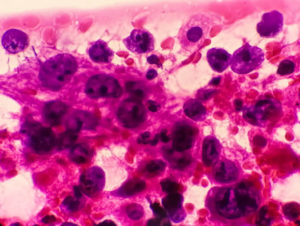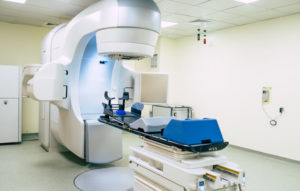Stage 4 Lung Cancer
Stage 4 is the final stage of lung cancer. In this stage, lung cancer tumors have spread into both lungs or other body parts like the bones or brain. However, it’s still possible to become a long-term stage 4 lung cancer survivor and live 10 years or more like some other patients have with the help of treatment.
What Is Stage 4 Lung Cancer?
In cases of stage 4 lung cancer, tumors have spread through the body and reached places far beyond the lungs.
- Adrenal glands
- Bones
- Both lungs (lung cancer typically starts in one lung only)
- Brain
- Liver
Stage 4 lung cancer is also known as advanced-stage lung cancer or metastatic lung cancer (meaning the cancer has spread).

Lung cancer can reach stage 4 if cancer cells travel to other body parts through blood or lymph nodes, according to the Cancer Treatment Centers of America (CTCA).
Stage 4 is more challenging to treat than earlier stages of lung cancer due to metastasis (tumor spread), but long-term survival may still be possible by getting top treatments from skilled doctors.
Our team can help you pursue compensation for stage 4 lung cancer treatments and other expenses. Find out your eligibility with a free case review right now.
- Access Financial Aid and Justice
- Learn About Your Options
- Contact Us for Free

Stage 4 Lung Cancer Symptoms
While there are typically little to no symptoms in the early stages of lung cancer, patients often experience uncomfortable symptoms by stage 4.
- A cough that won’t go away
- Appetite loss
- Bone pain
- Chest pain
- Coughing up blood
- Droopy eyelids
- Fatigue
- Fluid buildup in the lung lining (pleural effusion)
- Muscle weakness
- Shortness of breath
- Swelling in lymph nodes
- Weight loss
Stage 4 lung cancer patients may also suffer from headaches, dizziness, or numb limbs due to brain metastasis. They may develop jaundice (yellowing of the skin or eyes) if the tumors reach the liver and prevent it from functioning normally.
If you or a loved one is having any possible lung cancer symptoms, see a doctor as soon as possible. Prompt treatment for stage 4 lung cancer can ease symptoms and possibly help you live longer.
Types of Stage 4 Lung Cancer
The two main types of lung cancer are non-small cell lung cancer (NSCLC) and small cell lung cancer (SCLC). NSCLC is the only type with an official staging system (stages 0-4).
SCLC is classified into either a limited or extensive stage. Extensive-stage SCLC is usually the equivalent of stage 4 NSCLC as the cancer has spread throughout the body.
Learn more about the different types of stage 4 lung cancer below.
Stage 4 Non-Small Cell Lung Cancer
Patients are diagnosed with stage 4 non-small cell lung cancer if doctors find one or more tumors outside of the lung.
Stage 4 NSCLC has two substages:
- Stage 4A: One lung cancer tumor is found outside of the lungs.
- Stage 4B: Multiple tumors are found beyond the lungs.
NSCLC can spread to any part of the body if the cancer cells get into the bloodstream or lymph system.
Stage 4 NSCLC tumors are often found in the brain, bones, liver, pleura (lung lining), or pericardium (heart lining). The tumors may also invade the heart, blood vessels, or major lung airways.
It’s more common to be diagnosed in stage 4B than stage 4A, according to the CTCA.
Stage 4 Small Cell Lung Cancer
As noted above, there’s technically not a fourth stage of small cell lung cancer. That said, extensive-stage SCLC is similar to stage 4 NSCLC as the cancer has metastasized.
In extensive-stage SCLC, the cancer may have spread to lymph nodes, bones or bone marrow, the brain, the pleura, or both lungs, as noted by the American Society of Clinical Oncology (ASCO).
Further, doctors may determine that a patient has extensive-stage SCLC if they find more than one tumor in a lung.
Diagnosing Stage 4 Lung Cancer
If a doctor thinks you may have any stage of lung cancer, they’ll take several steps to make a diagnosis.


Your doctor will note your symptoms, any family history of cancer, and your overall health during an initial visit. Make sure to tell them if you ever smoked or were exposed to other possible causes of lung cancer, like asbestos.
They will then likely order imaging tests to look for signs of cancer in your body.
Tests used to make a stage 4 lung cancer diagnosis include:
- CT scan: Takes pictures at different angles to reveal tumors in the lungs, lymph nodes, liver, or other organs
- MRI scans: Uses magnetic waves to generate pictures of the body’s interior and helps show cancer spread to the brain or spinal cord
- PET scans: Helps doctors locate cancer tumors through the use of a small amount of radioactive sugar, which settles where the cancer is
The last step to diagnose stage 4 lung cancer is a biopsy, where doctors remove a small sample of fluid or tissue that could be cancerous and look at the cells under a microscope.
Doctors can then determine if you have stage 4 lung cancer based on the results of the biopsy and imaging scans. They may also order follow-up scans in other areas if they only looked at your lungs.
Many patients are diagnosed with stage 4 lung cancer as symptoms may not appear until the cancer has spread.
A 2021 study found that between 60% and 70% of non-small cell lung cancer (NSCLC) patients are diagnosed in the fourth stage. The American Cancer Society (ACS) found that roughly 66% of small cell lung cancer (SCLC) patients will be diagnosed in this late stage.
Get a free case review for help affording treatment costs and more if you were recently diagnosed with stage 4 lung cancer.
- Access Financial Aid and Justice
- Learn About Your Options
- Contact Us for Free




Stage 4 Lung Cancer Prognosis
Stage 4 lung cancer has the worst prognosis (health outlook) of all stages and many patients only live for a year or less after diagnosis.
But, factors like the patient’s age, overall health, and treatment plan all impact lung cancer prognosis. Some stage 4 patients can live for 10 years or more.
Stage 4 Lung Cancer Survival Rate
Survival rates for cancer indicate the percentage of people who are still alive after a set period of time (typically years).
The 5-year survival rate for patients with stage 4 NSCLC is 7%, according to the ASCO. The 5-year survival rate drops to 3% for patients with extensive-stage SCLC.
However, it’s important to remember that survival rates are just averages, and you may outlive them.
Stage 4 Lung Cancer Life Expectancy
Life expectancy is how long patients live on average with cancer. A 2020 study found that patients with stage 4 NSCLC live for only 4-9 months on average after diagnosis. Patients with extensive-stage SCLC live for roughly 8-13 months.
That said, it’s possible for stage 4 lung cancer patients to live for many years, depending on how the cancer responds to treatments. A 2021 study from Frontiers in Oncology found that the stage 4 lung cancer life expectancy with treatment was 10-15 years or longer for some patients.
Call (877) 446-5767 now to learn if you can get help paying for treatments to improve your stage 4 lung cancer prognosis.
Stage 4 Lung Cancer Treatment
Once doctors have made a stage 4 lung cancer diagnosis, they’ll recommend a treatment plan that can help the patient live longer and with less pain. Explore top stage 4 lung cancer treatment options below.
Stage 4 Lung Cancer Surgery
Major surgeries may or may not be used to treat stage 4 lung cancer.
“Surgery is usually not recommended if the tumor cannot be completely removed.”
— American Society of Clinical Oncology (ASCO)
Surgery may be possible for stage 4A NSCLC patients as there is only one tumor outside of the lungs. If chemotherapy can shrink the tumor, doctors have a better chance of removing all the cancer.
Surgery is rarely used to treat extensive-stage SCLC as there are usually multiple tumors, making chemotherapy the preferred treatment.
Chemotherapy
Many cases of stage 4 lung cancer are treated with chemotherapy (cancer-destroying medication).
According to the ACS, chemotherapy is the main treatment used in extensive-stage SCLC. It is also commonly used in stage 4 NSCLC, where it can destroy tumors in the lung and other areas, such as the liver or bones.
A patient must be in reasonably good overall health to undergo chemotherapy, as the side effects like fatigue, nausea, and hair loss can be taxing.
Immunotherapy
Immunotherapy can be used to treat both stage 4 NSCLC and extensive SCLC by enhancing the body’s immune response. It is usually given alongside chemotherapy.
Results from the ongoing DISCIPLE trial found that stage 4 NSCLC patients treated with immunotherapy had a progression-free survival of 15 months longer than those who received chemotherapy. This meant immunotherapy allowed patients to live for more time cancer-free.
Immunotherapy can cause side effects such as fatigue and bowel movement problems, which should be reported to caregivers and doctors if they occur.
Get a free case review for help affording stage 4 lung cancer treatments like immunotherapy.
- Access Financial Aid and Justice
- Learn About Your Options
- Contact Us for Free




Radiation Therapy
Radiation therapy (beams of energy that shrink cancer tumors) is often used to boost the effects of other stage 4 lung cancer treatments.


Radiation therapy also causes side effects like fatigue and hair loss, but if these are less severe than the side effects of chemotherapy, it may be a better fit for you.
Targeted Therapy
Targeted therapies identify lung cancer cells based on gene mutations and destroy them. Many targeted therapies are given in pill form and are used with other treatments like chemotherapy.
In cases of stage 4B NSCLC, targeted therapies are often the first treatments used, according to the ACS. Doctors test a patient’s tumor to see if a targeted therapy is usable.
Several targeted therapies exist and each works in a slightly different way. For example, an EGFR inhibitor prevents lung cancer cells from dividing by blocking a protein in them.
Targeted therapy is only available for stage 4 NSCLC patients, so those with late-stage SCLC will need other treatments.
Clinical Trials
Patients with stage 4 lung cancer may be able to access newer treatments through clinical trials. These trials test out emerging treatments or new combinations of existing ones to see if they help patients.
Patients can find nearby clinical trials for lung cancer by visiting the National Cancer Institute website or by asking their doctors.
There are many clinical trials that are testing treatments for various types and stages of lung cancer. As a result, As of April 2024, there are over 170 clinical trials currently recruiting patients with stage 4 lung cancer.
Stage 4 Lung Cancer Palliative Care Options
Because stage 4 lung cancer has spread through the body, it may not be possible to safely undergo life-extending treatments. However, patients can still receive palliative care to ease symptoms and have a better quality of life.
Palliative treatments for stage 4 lung cancer include:
- Laser therapy (destroying tiny cancer tumors with lasers)
- Low doses of chemotherapy and radiation
- Photodynamic therapy (using light to kill cancer cells)
- Pleurodesis (sealing the lung lining to prevent fluid buildup)
- Scaled-down surgeries
- Stent placement (a tube can be inserted to help patients breathe better)
- Thoracentesis (draining fluid buildup in the lung lining with a needle)
Palliative therapies can be given alongside life-extending ones or they may be the only treatments used, according to the CTCA.
Can Lung Cancer Stage 4 Be Cured?
While there’s no cure for every stage 4 lung cancer patient, some may be considered “cured” if treatments destroy all evidence of cancer in the body.
There are many stage 4 lung cancer survivors who have no evidence of disease, or who lived for many years with the cancer thanks to medical care.
Survivors of stage 4 lung cancer include:
- Anita, 6-year survivor: When Anita received her stage 4 NSCLC diagnosis in 2013, doctors said there was no way to help her. However, she bravely decided to get treated with chemotherapy, radiation, and immunotherapy. Though Anita passed away in 2020, she had greatly outlived her initial prognosis.
- Emily, 10+ year survivor: Emily’s diagnosis in her late 20s came as a shock as she was a college athlete and never smoked. Following treatment, Emily’s doctors declared she was free of lung cancer. Ten years after her initial diagnosis, there were still no signs of cancer in her body.
- Susan, 10+ year survivor: Susan was diagnosed with stage 4 lung cancer in 2012 and had a less than 2% chance of living for 5 years. However, she was determined to beat the cancer and underwent treatments like surgery and chemotherapy. Against the odds, she is now cancer-free.
“I was declared NED, which is no evidence of disease. If that’s not a miracle, I don’t know what is!”
— Susan, stage 4 lung cancer survivor
Depending on how your body responds to treatments, you may become a stage 4 lung cancer survivor as well.
Call (877) 446-5767 to learn if you qualify for compensation to afford stage 4 lung cancer treatments that may help you live longer.
How to Beat Lung Cancer Stage 4
A stage 4 lung cancer diagnosis is often shocking and scary. The good news is that support is available to help you live as long as possible.
Lung cancer is one of the most common cancers, and there are well-qualified doctors across the country who can provide treatment to help you.
With the right medical team, you may be able to:
- Beat stage 4 lung cancer
- Become a long-term survivor
- Manage symptoms and live with less pain
You might worry about how you’ll pay for treatments needed to fight stage 4 lung cancer. Thankfully, you may qualify for financial aid to help pay for your cancer treatments. Find out your eligibility now with a free case review.
Stage 4 Lung Cancer FAQs
How long can you live with stage 4 lung cancer?
The average life expectancy for stage 4 lung cancer patients is 4-13 months, but some people may go on to live for 10 years or more.
Your life expectancy after being diagnosed with stage 4 lung cancer depends on many factors, including your health and treatment plan.
Doctors can recommend treatments to help you live as long as possible with stage 4 lung cancer.
Can you beat stage 4 lung cancer?
Yes. Though stage 4 lung cancer is very serious, it’s possible to become a survivor with treatment. Even stage 4 lung patients who were considered incurable have been able to achieve survival.
Get a free case review now to find out how you can afford treatments that may help you beat lung cancer
Can chemotherapy cure stage 4 lung cancer?
Yes. Chemotherapy may help cure patients with stage 4 lung cancer, particularly when used alongside other treatments.
Ask your doctor if chemotherapy can help treat your particular case of stage 4 lung cancer.
Is stage 4 lung cancer very serious?
Yes. If your doctor says you have stage 4 lung cancer, you’ll need to get prompt medical treatment in order to live as long as possible.
Stage 4 lung cancer means the cancer has spread to different parts of your body, making it harder to treat. It can quickly be fatal without treatment.
Is stage 4 lung cancer the same as stage 4 mesothelioma?
No. Mesothelioma is a rare cancer that affects the lining of major body organs. Mesothelioma is sometimes mistaken for stage 4 lung cancer as it often develops in the lung lining, but they aren’t the same.
Doctors must take a different approach when treating mesothelioma than if the patient has lung cancer.
Since both mesothelioma and lung cancer can be caused by asbestos exposure — and since the cancers have similar symptoms — it’s important to talk to your doctor and get correctly diagnosed before starting treatments.
What is the stage 4 lung cancer life expectancy without treatment?
Without treatment, the life expectancy of stage 4 lung cancer is typically just a few months, as by this point, tumors have spread through the body. Cancer will shut down the body’s major functions without medical care.
For this reason, patients are highly encouraged to explore any and all treatment options, so they can hopefully improve their metastatic lung cancer life expectancy.
What are the stage 4 lung cancer survival rates by age?
Younger stage 4 lung cancer patients have better survival rates than older patients.
5-year stage 4 lung cancer survival rates by age are as follows:
- Patients under 50: 18.2%
- Patients 50-65: 10.8%
- Patients 65+: 7.3%
These survival rates come from the National Cancer Institute’s Surveillance, Epidemiology, and End Results (SEER) program.
It’s important to remember, though, that survival rates are just averages and may not reflect how long you are expected to live. Many stage 4 lung cancer patients have become long-term survivors.

